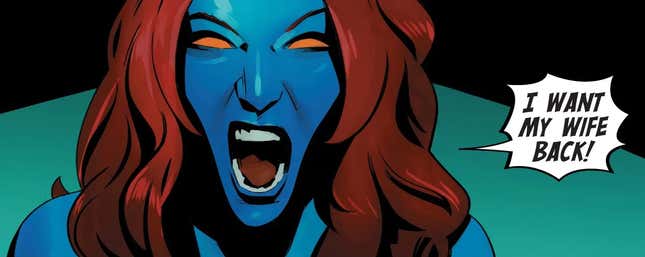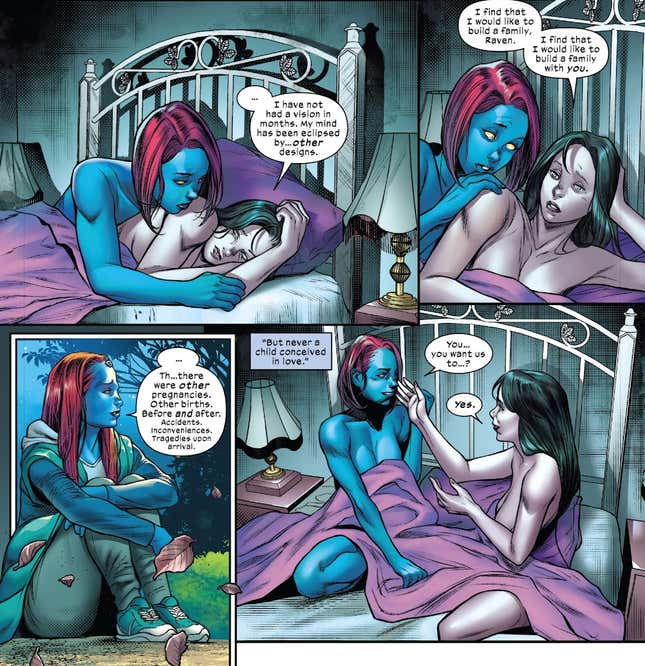
Kurt Wagner’s relationship with Mystique and Destiny has long been a messy, divisive one–but as the current era of X-Men comics is more explicit about their queer family, this week it righted the wrongs of the past to bring Kurt and his upbringing into a bold new light.

A lot’s happening with the X-Men right now, and mutantkind in general, as Marvel Comics heralds the final months of the “Krakoan Age”—the ascendant period of comics ushered in back in 2019 under the auspices of then-X-architect Jonathan Hickman that united mutants in their own, thriving sovereign nation. After the enemies of mutantdom played their hands at this year’s Hellfire Gala celebrations, slaughtering a new team of X-Men, Charles Xavier was forced to psychically cast the survivors—the remaining elements of mutantkind on the planet—from Earth. They’re now fugitives whose very discovery could lead to even more massacres. As they all operate in various layers of secrecy, some are handling it with a bit more drama than others: like Nightcrawler, who is currently appearing as New York’s latest Spider-Man in the pages of Uncanny Spider-Man. It’s honestly very funny and befitting Kurt to get by on the fact no one really acknowledges or cares when another new Spider-person shows up these days. This one teleports and kind of just looks like that fuzzy blue X-Man but in a mask? Sure.
But when Kurt came across Mystique—who everyone had presumed perished during the events of the Gala, when, resisting Charles’ psychic commands out of sheer will, she seemingly went mad and sent herself dashing against the rocks below—in New York, the stage was set for a complicated and dramatic reunion between wayward mother and son. Except that reunion, explored this week in the pages of Si Spurrier, Wilton Santos, Oren Junior, Marcus To, Ceci De La Cruz, and Joe Caramagna’s cheekily titled X-Men Blue: Origins, while complicated and dramatic, also made good on a re-working of Nightcrawler and Mystique’s relationship that is literally generations in the making.

As we currently understood it in X-Men continuity—as much as one can understand X-Men continuity as it has reshaped itself over the decades—Nightcrawler was Mystique’s biological son, born out of a relationship with the German nobleman Christian Wagner. When the birthing process, as well as the child’s blue skin, outed Mystique as a mutant, she and baby Kurt were chased out of their home by the locals and the former abandoned Kurt, leading to him being found and raised by the witch Margali Szardos. That twisted even further in the extremely controversial 2004 storyline “The Draco” by Chuck Austen, which retconned, in an attempt to explain Kurt’s demonic appearance and his teleportation power’s connection to the Brimstone Dimension, that Kurt was actually born of an affair between Mystique and the demon Azazel—and that Mystique abandoned him after his birth in part because she was tormented by her forlorn love for Azazel. It was not good, not for Kurt’s character, not for Mystique’s, not for anything. No one likes “The Draco.”
So good news: now “The Draco” only slightly matters! One of the many, many benefits of the Krakoan Age is how the comics have now been able to more textually and openly explore was, by and large for years, left largely unspoken of (even if extremely obvious to the reader)—the queer relationship of Mystique and the prophetic, long-lived mutant Irene Adler, aka Destiny. While the pair have been together across decades of X-Men comics, even after Destiny’s death, explicitly acknowledging that Mystique and Destiny were lovers on the page was a no-go up until the last few years, prevented by years of attempts to avoid controversy by Marvel and the specter of the Comics Code Authority. It was only in 2020 that Mystique was first allowed to specifically address Destiny as her partner, in a now-iconic panel from X-Men #6 where she tearfully screams to Charles Xavier that she wants her wife back.

Chris Claremont, the architect of the X-Men’s revival in the ‘70s, also purportedly long hand plans to reshape Nightcrawler’s origin story through more clearly establishing that he was born from Mystique and Destiny siring him via the former shape-shifting into a masculine form, but the plans were deemed too controversial at the time. Times have thankfully changed, however, and now, X-Men Blue: Origins is free to go back over Mystique, Destiny, and Nightcrawler’s fractured history and reforge it as a story of queer love and family.
Framed as the events of the Hellfire Gala and Charles’ psy-command as having broken through layers of shielded trauma, as she tearily tries to remember who she is and what happened to her son—unaware at first that her son is right beside her—X-Men Blue: Origins makes explicit just what Mystique’s mutant ability is, and just how powerful it always has been. Raven isn’t just simply a shapeshifter: her mutant power perfectly replicates her targets at a genetic level in an instant, reforging her entire body down to the cellular level at her command. And it’s in doing this that Mystique took on the masculine form of Azazel (part of a dalliance as well as unwittingly Destiny’s own prophetic visions of Azazel’s dire plans for the mutant race) to impregnate Irene with Kurt, the two hiding their centuries of romance together under the guise of Raven as Baron Wagner’s wife, and Irene as her maidservant. Mystique is Nightcrawler’s mother, his father, and everything all at once, because she has always been outside of a rigid gender binary—and even though they have both drifted apart from each other, loved other partners, Raven Darkhölme and Irene Adler have a marriage and love for each other that has spanned centuries.

Kurt was born out of Irene’s desire to start a family with the woman she loves most in the world, but also as part of one of her visions—a future glimpse that the genocide of the mutant race at Azazel’s hands could be thwarted by a child he believed to be his own. It was this tragic vision that saw Destiny and Mystique hunted after the former gave birth to Kurt, tearing them apart in the chaos, and one that saw Kurt’s own tragic separation from the person he had believed to be his mother just another threadline in the web of fate, putting him along the path of Margali, and eventually against Azazel himself.
In reality, Mystique’s flirtation with Azazel was nothing more than a cover, a brief fling with no real connection. The “reality” we previously saw, and explored further in “The Draco,” was in fact the work of none other than Charles Xavier himself. Turning to the Professor after Mystique and Destiny were reunited years later (and this time with the latest member of their family, the adopted Rogue, at their side) to help ensure the Irene’s vision would come to pass, Xavier psychically altered their memory’s of Kurt’s true birth, replacing it with the shielded imaginings that had long previously been X-Men canon.

But that is now no more. Xavier’s false memories were broken apart by Raven’s sheer force of will in resisting him at the Gala, and although she herself was left broken by that tragic event, she still managed—through fate or otherwise—to get herself to safety and to her son’s side. Destiny might still be separated from the duo, for now, but for the first time in decades, Nightcrawler and Mystique truly understand their relationship, and can move forward and heal together—while one of the greatest, often unspoken queer loves of X-Men comics gets to be woven back through history as it always intended to be along the way.
Want more io9 news? Check out when to expect the latest Marvel, Star Wars, and Star Trek releases, what’s next for the DC Universe on film and TV, and everything you need to know about the future of Doctor Who.






